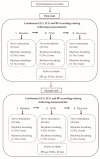Men Show Reduced Cardiac Baroreceptor Sensitivity during Modestly Painful Electrical Stimulation of the Forearm: Exploratory Results from a Sham-Controlled Crossover Vagus Nerve Stimulation Study
- PMID: 34769711
- PMCID: PMC8582936
- DOI: 10.3390/ijerph182111193
Men Show Reduced Cardiac Baroreceptor Sensitivity during Modestly Painful Electrical Stimulation of the Forearm: Exploratory Results from a Sham-Controlled Crossover Vagus Nerve Stimulation Study
Abstract
This paper presents data from a transcutaneous vagus nerve stimulation experiment that point towards a blunted cardiac baroreceptor sensitivity (cBRS) in young males compared to females during electrical stimulation of the forearm and a rhythmic breathing task. Continuous electrocardiography, impedance cardiography and continuous blood-pressure recordings were assessed in a sex-matched cohort of twenty young healthy subjects. Electrical stimulation of the median nerve was conducted by using a threshold-tracking method combined with two rhythmic breathing tasks (0.1 and 0.2 Hz) before, during and after active or sham transcutaneous vagus nerve stimulation. Autonomic and hemodynamic parameters were calculated, and differences were analyzed by using linear mixed models and post hoc F-tests. None of the autonomic and hemodynamic parameters differed between the sham and active conditions. However, compared to females, male participants had an overall lower total cBRS independent of stimulation condition during nerve stimulation (females: 14.96 ± 5.67 ms/mmHg, males: 11.89 ± 3.24 ms/mmHg, p = 0.031) and rhythmic breathing at 0.2 Hz (females: 21.49 ± 8.47 ms/mmHg, males: 15.12 ± 5.70 ms/mmHg, p = 0.004). Whereas vagus nerve stimulation at the left inner tragus did not affect the efferent vagal control of the heart, we found similar patterns of baroreceptor sensitivity activation over the stimulation period in both sexes, which, however, significantly differed in their magnitude, with females showing an overall higher cBRS.
Keywords: heart rate variability; nerve stimulation; sex differences; spontaneous baroreceptor sensitivity; stress; transcutaneous vagus nerve stimulation.
Conflict of interest statement
The authors have no conflict of interest to declare that are relevant to the content of this article.
Figures



Similar articles
-
Non-invasive vagus nerve stimulation acutely improves spontaneous cardiac baroreflex sensitivity in healthy young men: A randomized placebo-controlled trial.Brain Stimul. 2017 Sep-Oct;10(5):875-881. doi: 10.1016/j.brs.2017.05.006. Epub 2017 May 19. Brain Stimul. 2017. PMID: 28566194 Clinical Trial.
-
Impact of optimized transcutaneous auricular vagus nerve stimulation on cardiac autonomic profile in healthy subjects and heart failure patients.Physiol Meas. 2024 Jul 17;45(7). doi: 10.1088/1361-6579/ad5ef6. Physiol Meas. 2024. PMID: 39016202 Clinical Trial.
-
Cardiovascular responses to low-level transcutaneous vagus nerve stimulation.Auton Neurosci. 2021 Dec;236:102851. doi: 10.1016/j.autneu.2021.102851. Epub 2021 Jul 14. Auton Neurosci. 2021. PMID: 34274638
-
Does transcutaneous auricular vagus nerve stimulation affect vagally mediated heart rate variability? A living and interactive Bayesian meta-analysis.Psychophysiology. 2021 Nov;58(11):e13933. doi: 10.1111/psyp.13933. Epub 2021 Sep 2. Psychophysiology. 2021. PMID: 34473846 Review.
-
Effects of transcutaneous auricular vagus nerve stimulation on cardiovascular autonomic control in health and disease.Auton Neurosci. 2021 Dec;236:102893. doi: 10.1016/j.autneu.2021.102893. Epub 2021 Oct 9. Auton Neurosci. 2021. PMID: 34649119 Review.
Cited by
-
Prevalence rates of metabolic health and body size phenotypes by different criteria and association with insulin resistance in a Maltese Caucasian population.BMC Endocr Disord. 2022 Jun 15;22(1):160. doi: 10.1186/s12902-022-01071-x. BMC Endocr Disord. 2022. PMID: 35706017 Free PMC article.
-
Expiratory-gated Transcutaneous Auricular Vagus Nerve Stimulation (taVNS) does not Further Augment Heart Rate Variability During Slow Breathing at 0.1 Hz.Appl Psychophysiol Biofeedback. 2023 Sep;48(3):323-333. doi: 10.1007/s10484-023-09584-4. Epub 2023 Mar 15. Appl Psychophysiol Biofeedback. 2023. PMID: 36920567 Free PMC article.
-
Acute effect of transcutaneous auricular vagus nerve stimulation on cardiac vagal activity in men living with HIV: A proof-of-concept clinical trial.PLoS One. 2025 Aug 19;20(8):e0326793. doi: 10.1371/journal.pone.0326793. eCollection 2025. PLoS One. 2025. PMID: 40828846 Free PMC article.
References
-
- Colpani V., Baena C.P., Jaspers L., van Dijk G.M., Farajzadegan Z., Dhana K., Tielemans M.J., Voortman T., Freak-Poli R., Veloso G.G.V., et al. Lifestyle Factors, Cardiovascular Disease and All-Cause Mortality in Middle-Aged and Elderly Women: A Systematic Review and Meta-Analysis. Eur. J. Epidemiol. 2018;33:831–845. doi: 10.1007/s10654-018-0374-z. - DOI - PubMed
-
- Walli-Attaei M., Joseph P., Rosengren A., Chow C.K., Rangarajan S., Lear S.A., AlHabib K.F., Davletov K., Dans A., Lanas F., et al. Variations between Women and Men in Risk Factors, Treatments, Cardiovascular Disease Incidence, and Death in 27 High-Income, Middle-Income, and Low-Income Countries (PURE): A Prospective Cohort Study. Lancet. 2020;396:97–109. doi: 10.1016/S0140-6736(20)30543-2. - DOI - PubMed
-
- Zou Z., Cini K., Dong B., Ma Y., Ma J., Burgner D.P., Patton G.C. Time Trends in Cardiovascular Disease Mortality Across the BRICS: An Age-Period-Cohort Analysis of Key Nations With Emerging Economies Using the Global Burden of Disease Study 2017. Circulation. 2020;141:790–799. doi: 10.1161/CIRCULATIONAHA.119.042864. - DOI - PubMed
Publication types
MeSH terms
LinkOut - more resources
Full Text Sources

